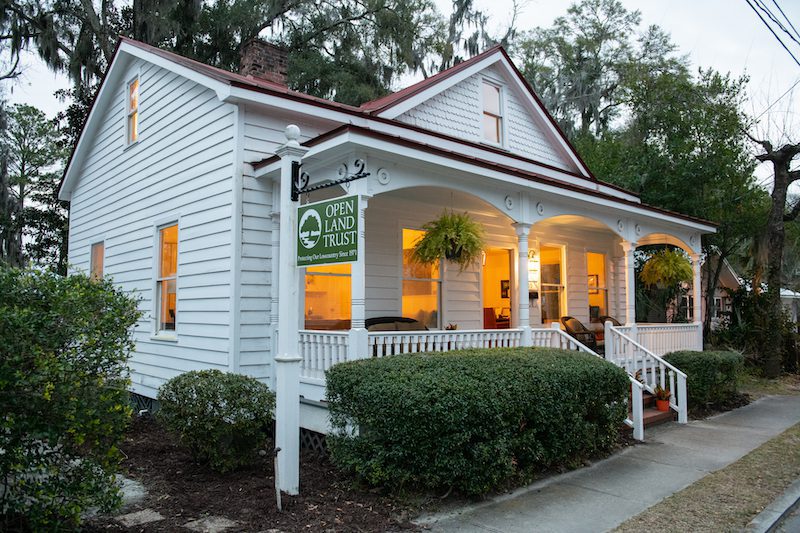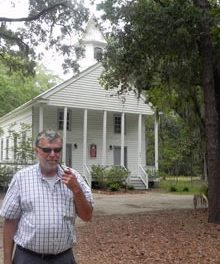Story & photos by Tony Kukulich

Caylor Romines, Kate Schaefer and Kristen Williams of the OLT
The Beaufort County Open Land Trust (OLT) – an organization dedicated to land preservation across a seven-county region – was the veritable definition of a grassroots organization in its early days, but now is a major force in South Carolina land conservation.
A map on the wall of their new conference room plots the 28,000 acres the group has protected over its history, evidence of the success that the group has worked hard to achieve.
“Last year we celebrated our 50th anniversary,” said Kristin Williams, OLT executive director. “We were the first land trust in the State of South Carolina. It started here in Beaufort. There is really an amazing community-conservation ethic here in Beaufort. The forethought and vision of the community to start this is really special.”

The OLT has had more to celebrate over the last few months than just its golden anniversary. Trust staff recently moved into new, permanent accommodations located at 905 Charles Street in downtown Beaufort. Williams, excited about the organization’s new “forever home” said she hopes people will stop in to learn about the work the trust does.
A ribbon-cutting ceremony was held Jan. 20 on the building’s
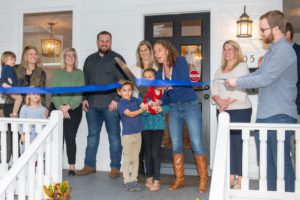
Executive Director Kristin Williams gets help cutting the ribbon.
front porch. Gray skies and light rain threatened to dampen festivities, but ultimately proved harmless. Beaufort Mayor Stephen Murray and Beaufort Regional Chamber of Commerce’s Megan Morris joined the OLT staff as Williams, with help from her children, cut the ribbon and gave attendees their first look at the new space.
“We are so fortunate to have the Open Land Trust working diligently now for 50 years in the Lowcountry to preserve thousands of acres across our region,” Murray said. “I am excited they now have a permanent home, and the City of Beaufort congratulates their board and staff on the new Charles Street location.”
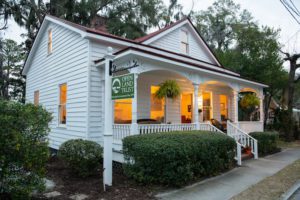
The OLT’s new “forever home”
If the anniversary and new home weren’t enough, the land trust also recently played a key role in the preservation of more than 2,000 acres along the Wimbee River in St. Helena Sound – a property known as Oak Point. The property also lies just north of Runway 05/23 at the Marine Corps Air Station Beaufort. The effort saw the Department of Defense (DOD) split the $5.8 million cost with the Beaufort County Rural and Critical Land Preservation Program, while the DOD and the OLT jointly hold the conservation easement.
“Protecting this property has an incredible public benefit because it further protects waterfront in the St. Helena Sound,” Williams said in a press release earlier this year. “Protecting Oak Point has individual value – to wildlife, water quality, fishing and recreational interests, and the military – but due to its location in the middle of a protected landscape, the public benefits are multiplied even further.”
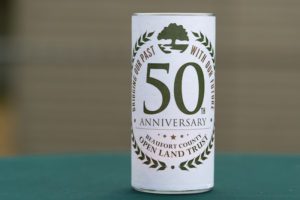
At the very beginning of the OLT story in the early 70s, a couple of neighbors chatting over coffee commented on the appearance of “for sale” signs on the bluff overlooking Bay Street in Beaufort. Concerned over the impact of development on the bluff, those neighbors soon secured a $10,000 loan to purchase the property, and the land was kept out of the hands of developers.
“That was the start of the Open Land Trust,” Williams said. “They paid for that property by selling potholders on Bay Street and hosting chicken salad lunches for tour groups. After they did that they bought another piece of property.”
The second acquisition resulted in the demolition of buildings that obstructed the view of the Beaufort River from Bellamy Curve on Carteret Street. Tearing down buildings in the name of conservation was an unconventional move at the time, particularly for a fledgling organization. In retrospect, it signaled the extent of OLT’s commitment to preservation and foreshadowed the role the organization would assume in preservation efforts across the region in the coming decades.
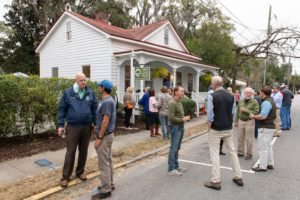
A crowd gathers for the OLT ribbon cutting
“We’re really proud of the work we’ve done,” Williams said. “We’re unique in that we own a lot of land, where a lot of trusts don’t. But we’ve been around a long time. We own 50 properties in fee, which accounts for just over 700 acres of the 28,000 (acres) we’ve protected.
According to Williams, conservation easements are the key to preserving lands. Unlike zoning changes, easements cannot be undone. They transfer with the property from owner to owner. Once a deal is inked, the terms of that easement, for all intents and purposes, are forever.
“Conservation easements are a perpetual restriction or development standard that is affixed to a property,” explained Kate Schaefer, director of land protection. “It’s a legal agreement that lays out how the property will or will not be developed forever. Those conservations are written between the land trust and the landowners. We hold the easement and the landowner grants the easement. They’re specific to each property to protect its conservation value.”
The process usually starts with the landowner reaching out to the

Beaufort Mayor Stephen Murray speaks at the OLT ribbon cutting
trust and expressing an interest in preserving their property, though the trust has also approached landowners in some circumstances. A survey is completed to determine the preservation value and an easement is written that can restrict things like subdividing the property or changing the way the land is used. Deep setbacks can be required to preserve scenic views.
“Roads and rooftops are typically limited to 0.5% of the whole property,” stated Schaefer. “That helps reinforce the watershed benefits of a property. We know that research in this part of the country has advanced this theory that a watershed becomes impaired whenever 10% of it is paved. Easements to protect conservation values often relate tremendously to water quality, so impervious surfaces are a big indicator that we look at.”
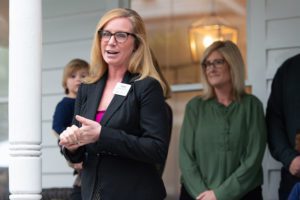
Megan Morris of the Beaufort Chamber of Commerce speaks at the OLT ribbon cutting
In some cases, the landowner receives financial compensation beyond the tax benefits that come with a conservation easement. Like the Oak Point project, funding often comes from a county program.
“Beaufort County taxpayers have opted to tax themselves to fund a program to offer financial incentives,” Schaefer said. “That’s the Rural and Critical Lands Program. It’s been arounds since 2002. It’s pretty progressive. We were the first county in the state to do it, and right now we’re one of three (counties). The first land trust in the state started in Beaufort County. The first funding program started here. We’ve got a very forward-thinking history.”
Caylor Romines, OLT director of stewardship, said that over the

Kristin Williams, executive director of the Beaufort County Open Land Trust
last few years a change in the real estate market has occurred in which property with a conservation easement has increased in value over properties with no such agreement. Schaefer attributed the shift to the certainty that a conservation easement adds to the landscape.
“When people buy property in our coastal plain, there’s certainty to that natural resource value because of what people have done over the last 50 years,” she added. “That has created value.”
With 2,700 acres over five parcels protected, a new home and a milestone anniversary, things have been busy for the OLT staff. With her team firing on all cylinders, Williams doesn’t see things slowing down in the upcoming year.
“When we look at a map, that’s where we measure our success,” she said. “We see the difference that we’ve been able to make. It’s not short term. When you invest in this, it’s a long-term investment. That’s why it’s important to celebrate each victory, because it’s adding a piece to the puzzle.”

